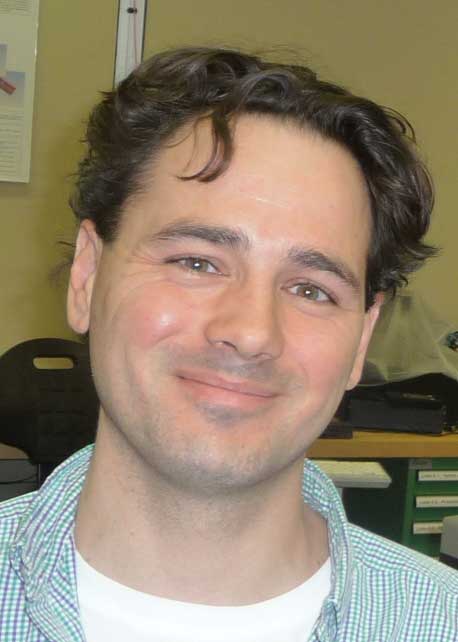Colloquia & Guest Speakers
Multi-section semiconductor lasers
Nicholas Usechack, Air Force Research Lab, Wright Patterson AFB, Ohio
Monday, September 29, 2014
3 p.m.–4:30 p.m.
Goergen 101, Sloan Auditorium
Abstract:
A semiconductor laser segmented into a plurality of electrically isolated regions provides the ability to electrically extract carriers (creating a saturable absorber) or inject carriers (creating a gain media) based only on biasing conditions. Taking advantage of this feature by dynamically addressing a multi-section semiconductor laser enables devices which provide a versatile source suitable for some degree of agile waveform generation.
In this talk we will discuss experimental results obtained from a two-section passively mode-locked quantum-dot laser. A minimal model for the laser was originally used to investigate the device performance and will be reviewed. This model, which folds the spatial evolution into the time domain by using spatial averaging and delay differential equations, reveals pulse asymmetry that favorably agrees with electricfield measurements. Results showing single-pulse operation as well as the other laser operating regimes of harmonic mode locking, q-switching, oscillation, and cw operation will be presented. As a consequence of the delay, these equations can be viewed as having memory which engenders them with hysteresis. While this should provide any local solution with an added (physically meaningful) robustness against perturbations, it also complicates standard stability analysis. To gain insight into the stability of the model we have focused on a mode-locked region where multiple well-defined co-existing attractors have been numerically predicted. Results investigating stability of these results will be noted. Observations from directly solving a partial differential equation system which represents the electricfield evolution in these lasers will also be shown. Although the solution to these equations yields results similar to those obtained from the reduced model, it provides greater insight into the operation of these devices. For example, it allows one to view the evolution of the fields within the laser cavity; this can be important especially in the case of harmonic mode locking. This model is also useful in analyzing compact reduced models and it can easily be extended to devices with an arbitrary number of sections. The small-signal modulation response of a segmented-cavity semiconductor laser will also be discussed. In particular the different mechanisms responsible for creating dips and peaks in the modulation response will be clarified. The role played by the lengths of the two sections in a gain-levered semiconductor laser will be investigated in detail. Here the use of delay differential equations has been found to produce good agreement with computer simulations of the above modulation phenomenon.
Bio:
 Nicholas G. Usechak was born in Long Branch, NJ, in 1976. He received B.S. degrees with high honors in both electrical engineering and engineering physics from Lehigh University, Bethlehem, PA, in 2000. In 2003 he received an M.S. degree and in 2006 a Ph.D. both in optical engineering from the Institute of Optics, University of Rochester, Rochester NY where his dissertation focused on experimental work, numerical modeling, and the theory of FM mode-locked fiber lasers. He worked at Trumpf Photonics in Cranbury, NJ as a Senior Engineer for a year following graduation characterizing high-power semiconductor laser arrays, automating experiments, and modeling the thermal effects of solder interfaces using transient temperature-extraction experiments to ground those models. After Trumpf he joined the Air Force Research Laboratory at Wright–Patterson Air Force Base where he is currently employed as a Senior Electronics Engineer. At Lehigh he was a Presidential Scholar during the academic year 1999-2000. At the University of Rochester he conducted his experimental work in the Laboratory for Laser Energetics where he was a Frank J. Horton Fellow. His research interests include integrated photonic devices and systems, nonlinear optics, fiber lasers, semiconductor lasers, ultrafast optics, high-speed test and measurement, high-power semiconductor lasers, mode-locked lasers, parametric processes, optical clock generation, novel gain media, and diverse waveform generation.
Nicholas G. Usechak was born in Long Branch, NJ, in 1976. He received B.S. degrees with high honors in both electrical engineering and engineering physics from Lehigh University, Bethlehem, PA, in 2000. In 2003 he received an M.S. degree and in 2006 a Ph.D. both in optical engineering from the Institute of Optics, University of Rochester, Rochester NY where his dissertation focused on experimental work, numerical modeling, and the theory of FM mode-locked fiber lasers. He worked at Trumpf Photonics in Cranbury, NJ as a Senior Engineer for a year following graduation characterizing high-power semiconductor laser arrays, automating experiments, and modeling the thermal effects of solder interfaces using transient temperature-extraction experiments to ground those models. After Trumpf he joined the Air Force Research Laboratory at Wright–Patterson Air Force Base where he is currently employed as a Senior Electronics Engineer. At Lehigh he was a Presidential Scholar during the academic year 1999-2000. At the University of Rochester he conducted his experimental work in the Laboratory for Laser Energetics where he was a Frank J. Horton Fellow. His research interests include integrated photonic devices and systems, nonlinear optics, fiber lasers, semiconductor lasers, ultrafast optics, high-speed test and measurement, high-power semiconductor lasers, mode-locked lasers, parametric processes, optical clock generation, novel gain media, and diverse waveform generation.
Dr. Usechak is a member of the OSA, Tau Beta Pi, Sigma Xi, and a Senior Member of the IEEE.
